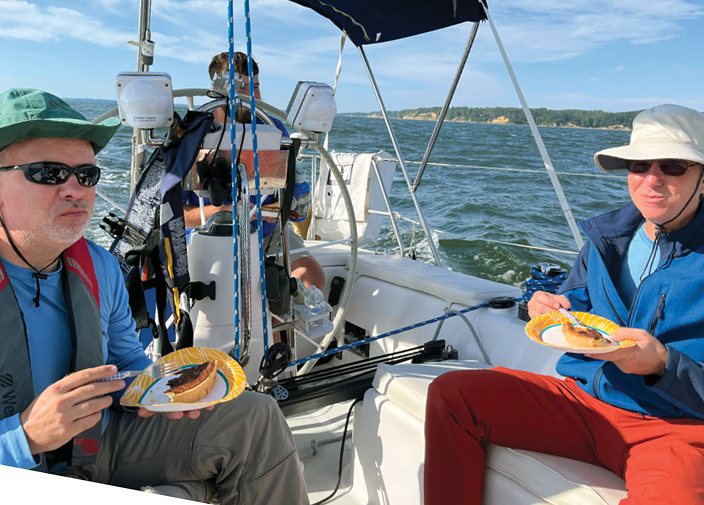Galley-smart cooking
Whether you’re cruising or racing, if you’re on the water for more than a few hours, your crew’s gonna get hungry! Planning your meals should take several factors into account, given the relatively limited galley typical of most sailing vessels (unless of course, your name is Richard Branson or Jimmy Buffett). Here are six key factors to consider, as well as some menu ideas for the practical sailor.

- How long will you be on the water? Even if you’re just daysailing or doing a buoy race, if you’ll be on the water spanning a typical mealtime, you need to provision your crew with some nourishment. Simple snacks to bring aboard could include a selection of fruit, veggie sticks, snack bars, cheese and crackers, and more. Don’t forget the ginger snaps to help reduce mild cases of motion sickness.
- Refrigeration—For longer trips, a portable cooler might not be practical, as it could need additional ice to keep the temperature down. If you have an onboard fridge, you’ll be able to keep cold items onboard for a longer period. Make sure your crew knows what to expect if they’re helping to provision the boat.
- Preparation—Preparation area, storage, cooking tools, and ingredients tend to run scarce onboard. Anything you can prepare in advance (or purchase pre-prepared) can dramatically expand menu options onboard. One crewmember recently brought a Ziploc bag with premade French toast that simply needed to be cooked in a pan. Another crewmember brought a storebought quiche that we simply threw into our onboard oven for 30 minutes, providing a warm and tasty breakfast for the crew while underway.
- Cooking/heating—Larger sailboats and cruisers tend to have onboard gas ranges, ovens, and even barbecue grills, enabling hot foods to be prepared onboard, ashore, and underway. Be sure to factor rough waves and weather into consideration before lighting up the onboard range. Also factor in cooking splatter, smoke, and grease. One crew member pan-fried an amazing steak aboard my J/120 Hot Pepper making a total grease splatter mess of the entire galley area and overhead surfaces while filling the cabin with smoke.
- Eating—Enjoying an onboard meal in a peaceful anchorage is one thing, but trying to down a meal topsides while underway in heavy waves is a whole different situation. When you’re racing, there’s a good chance all your crew will be on deck, likely balancing a bowl or plate in their lap as the boat pitches and rolls through the waves. Handing up a plate that requires a knife and fork may not end well for the plate, the meal, or your deck when that rogue wave sends the crew reaching for a handhold at the cost of their dinner. The fewer plates and utensils required, the better. Ideally, no plate/no fork works best on deck.
- Cleaning—In my experience, the less onboard cleanup, the better. A clogged drain is no fun, and it’s awfully hard to get a plumber to make house calls out in the middle of the Bay. Before you decide to bake a casserole in your onboard oven, think about how difficult it is to clean that pan at home, let alone aboard.
Given these factors, here are some simple meals that work well for me and my crew aboard Hot Pepper at rest and underway.
Breakfast: When the boat's at rest, pancakes, eggs, sausage, hot or cold cereal, fruit, and French toast work well. Underway or at rest I like donuts, bagels, pastries, and store-bought/premade quiche.
Lunch: At rest, I find that leafy green salads, pasta salads, chicken salad, and soup are good choices. Underway or at rest, I suggest sandwiches, wraps, and other handheld foods.
Dinner: When the boat's at rest, shrimp and grits, steak, burgers, pasta, and store-bought/premade lasagna work well. Underway or at rest, pizza, store-bought/premade cold fried chicken pieces, and quesadillas are good choices.
Whatever your journey has in store for you, the goal should be to provide the best meal for your crew with minimal space, prep, consumption, and cleanup required. Hopefully, this gives you some ideas on how to keep your crew happy, healthy, and well-fed while out on your boat.
by Captain Steven Toole
About the Author: Captain Steven Toole covers cruising, destinations, and other Bay-related topics for SpinSheet. He races and cruises his J/120 Hot Pepper on the Chesapeake Bay and holds a USCG Master Captain's License.




